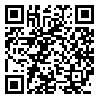Volume 6, Issue 23 (11-2012)
etiadpajohi 2012, 6(23): 27-37 |
Back to browse issues page
Download citation:
BibTeX | RIS | EndNote | Medlars | ProCite | Reference Manager | RefWorks
Send citation to:



BibTeX | RIS | EndNote | Medlars | ProCite | Reference Manager | RefWorks
Send citation to:
Enayat J, Javanmard G, Mammagani J. The Comparison of Attention Biases to Opiates in Substance Dependent and Treated Clients of Therapeutic Clinics and Narcotics Anonymous Memberships . etiadpajohi 2012; 6 (23) :27-37
URL: http://etiadpajohi.ir/article-1-316-en.html
URL: http://etiadpajohi.ir/article-1-316-en.html
Abstract: (10271 Views)
Aim: The purpose of this study was to compare the attention bias about tempting incentives related to opium materials in treated, addicted and normal people. Duration of consumption and treating were also considered. Method: In this causal-comparative study population was all addicted people who were referred to the rehabilitation offices, addiction treatment clinic, rebirthing centers and Narcotics Anonymous of East Azerbaijan. This study consisted of five groups of men, including addicted to opium materials which are divided into two groups namely: long consumption period and people with short consumption period, also, treated people including long term treated and short term treated, and a normal control group. Altogether, 103 selected people were studied. Sample groups were similar in terms of age, education, and sex. For measuring attention bias towards tempting stimuli related opiates, a words recognition test was used. This test included three subtests and one recognition test. The recognition scores for the three categories of words were measured. Results: The findings indicated that there was a difference in attention against opium material incentives between control group and the mild and severe consumers groups. Also there were significant differences between treated people with the short time distance and control group, and control group had less temptation and biases in comparison to the other groups. Finally, those who have mild consumption are threatened more in comparison with the control group. Conclusion: The findings have applied implications.
Type of Study: Research |
Subject:
General
Received: 2014/05/14 | Accepted: 2014/05/14 | Published: 2014/05/14
Received: 2014/05/14 | Accepted: 2014/05/14 | Published: 2014/05/14
| Rights and permissions | |
 |
This work is licensed under a Creative Commons Attribution-NonCommercial 4.0 International License. |





